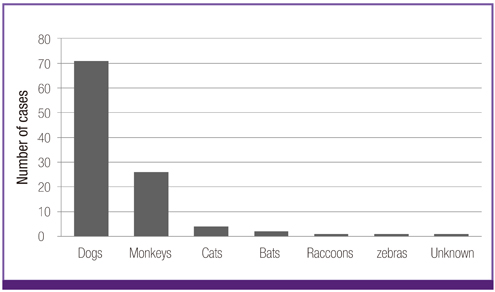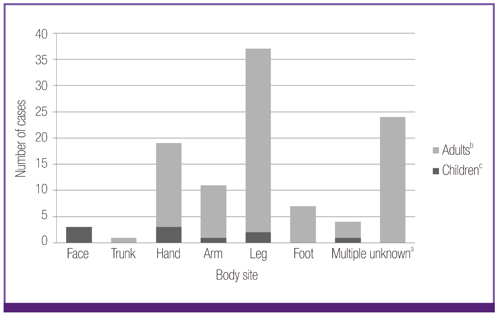Infect Chemother.
2014 Mar;46(1):13-20. 10.3947/ic.2014.46.1.13.
Rabies Post-Exposure Prophylaxis of Overseas Travelers in the International Travel Clinic of the National Medical Center from 2006 to 2012, Korea
- Affiliations
-
- 1Department of Pediatrics, National Medical Center, Seoul, Korea. nmcmpkjy@unitel.co.kr
- 2Department of Internal Medicine, National Medical Center, Seoul, Korea.
- 3International Travel Clinic, National Medical Center, Seoul, Korea.
- KMID: 2170455
- DOI: http://doi.org/10.3947/ic.2014.46.1.13
Abstract
- BACKGROUND
Rabies is an acute fatal viral disease generally transmitted from infected animals to humans through bites. It is distributed worldwide. The number of Korean people traveling to rabies-endemic countries and being bitten by infected animals has been increasing recently. Therefore, we investigated international travelers who received rabies post-exposure prophylaxis (PEP) at the National Medical Center (NMC) and compared the data with those of other clinics.
MATERIALS AND METHODS
This study was a retrospective review of 106 patients who visited the International Travel Clinic of the NMC and received rabies PEP between July 2006 and December 2012. During that period, we used the Essen intramuscular regimen protocol. Complete rabies PEP was defined as 5 doses of rabies vaccination with or without rabies immunoglobulin (RIG) administration according to the World Health Organization guidelines.
RESULTS
A total 106 cases documented within the period of 6 years were selected, including 10 children younger than 15 years and 96 older than 15 years. The mean age of the patients who received PEP was 33.4 years. Of the patients, 53 were male and another 53 were female. Most of the exposures occurred in Southeast Asia, predominantly from dog bites (71, 66.9%). The lower extremities were the most frequent site of exposure (37, 34.9%). All the patients began receiving rabies vaccination for prophylaxis after exposure, and 51 received rabies vaccination with RIG. Meanwhile, 74 cases (69.8%) initiated rabies vaccination overseas, but only 10 of them received RIG while overseas; the remaining 32 (30.2%) initiated rabies vaccination after returning to Korea. Within 7 days, all the children and 74 adults received their first rabies vaccination. Six adults initiated first rabies vaccination after 1 week. Eleven of the 106 patients stopped PEP before 5 doses, among whom 4 (1 child and 3 adults) discontinued vaccination after confirming that the biting animal remained healthy throughout 10 days of observation. None of the patients had been previously vaccinated against rabies.
CONCLUSIONS
Most of the overseas travelers who visited our clinic after being bitten by suspected rabid animals received appropriate rabies PEP. However, the interval between exposure and first rabies vaccination was often delayed. Tourists who plan to travel in rabies enzootic regions need to be aware that prompt initiation of PEP is important to reduce the risk for developing human rabies.
Keyword
MeSH Terms
Figure
Cited by 2 articles
-
Prophylaxis of Human Hydrophobia in South Korea
Yang Ree Kim
Infect Chemother. 2014;46(3):143-148. doi: 10.3947/ic.2014.46.3.143.Application of recombinant adenoviruses expressing glycoprotein or nucleoprotein of rabies virus to Korean raccoon dogs
Jiyoung Choi, Dong-Kun Yang, Ha-Hyun Kim, Hyun-Ye Jo, Sung-Suk Choi, Jong-Taek Kim, In-Soo Cho, Hee-Won Kim
Clin Exp Vaccine Res. 2015;4(2):189-194. doi: 10.7774/cevr.2015.4.2.189.
Reference
-
1. Meslin FX. Rabies as a traveler's risk, especially in high-endemicity areas. J Travel Med. 2005; 12:Suppl 1. S30–S40.
Article2. Wunner WH, Briggs DJ. Rabies in the 21st century. PLoS Negl Trop Dis. 2010; 4:e591.
Article3. Han MY, Cho JE, Seo SY, Jeong YE. Epidemiological features of animal bite cases occurred in highly risk areas of rabies in Korea, 2005 to 2008. In : 20th International Conference on Rabies in the Americas; 2009. p. 45–46.4. Gautret P, Schwartz E, Shaw M, Soula G, Gazin P, Delmont J, Parola P, Soavi MJ, Matchett E, Brown G, Torresi J. GeoSentinel Surveillance Network. Animal-associated injuries and related diseases among returned travellers: a review of the GeoSentinel Surveillance Network. Vaccine. 2007; 25:2656–2663.
Article5. Korea Centers for Disease Control and Prevention. Human rabies prevention and control. 2007. Accessed 21 June 2013. Available at: http://www.cdc.go.kr/CDC/cms/cmsFileDownload.jsp?fid=51&cid=9803&fieldName=attach1&index=1.6. World Health Organization. Recommendations on rabies post-exposure treatment and the correct technique of intradermal immunization against rabies. HYPERLINK "https://www.google.co.kr/url?q=http://www.who.int/&sa=U&ei=-koqU-OdLM2-kQXk3IDwAQ&ved=0CCAQFjAA&sig2=3oSkKgZhiN-ztohGRryzog&usg=AFQjCNHzge5cWim6pocYzhODW-P-6LA70Q" \t "_blank". Accessed 21 June 2013. Available at: http://www.who.int/rabies/en/WHO_recommendation_post_exp_treatment.pdf.7. Madhusudana SN, Sukumaran SM. Antemortem diagnosis and prevention of human rabies. Ann Indian Acad Neurol. 2008; 11:3–12.
Article8. Noh JC, Park HM, Park JH, Won YK, Lee CH, Kim JY. Five year experience of preexposure and postexposure rabies prophylaxis in Korean children at the National Medical Center. Korean J Pediatr Infect Dis. 2013; 20:9–16.
Article9. Sibunruang S, Tepsumethanon S, Raksakhet N, Tantawichien T. Rabies immunization of travelers in a canine rabies endemic area. J Travel Med. 2013; 20:159–164.
Article10. Wijaya L, Ford L, Lalloo D. Rabies postexposure prophylaxis in a UK travel clinic: ten years' experience. J Travel Med. 2011; 18:257–261.
Article11. Pandey P, Shlim DR, Cave W, Springer MF. Risk of possible exposure to rabies among tourists and foreign residents in Nepal. J Travel Med. 2002; 9:127–131.
Article12. Shaw MT, O'Brien B, Leggat PA. Rabies postexposure management of travelers presenting to travel health clinics in Auckland and Hamilton, New Zealand. J Travel Med. 2009; 16:13–17.
Article13. Gautret P, Shaw M, Gazin P, Soula G, Delmont J, Parola P, Soavi MJ, Brouqui P, Matchett DE, Torresi J. Rabies postexposure prophylaxis in returned injured travelers from France, Australia, and New Zealand: a retrospective study. J Travel Med. 2008; 15:25–30.
Article14. Susilawathi NM1, Darwinata AE, Dwija IB, Budayanti NS, Wirasandhi GA, Subrata K, Susilarini NK, Sudewi RA, Wignall FS, Mahardika GN. Epidemiological and clinical features of human rabies cases in Bali 2008-2010. BMC Infect Dis. 2012; 12:81.
Article15. Anonymous. Rabies vaccines. WHO position paper. Wkly Epidemiol Rec. 2010; 85:309–320.16. Dimaano EM, Scholand SJ, Alera MT, Belandres DB. Clinical and epidemiological features of human rabies cases in the Philippines: a review from 1987 to 2006. Int J Infect Dis. 2011; 15:e495–e499.
Article17. Korea Centers for Disease Control and Prevention. Epidemiology and prevention of vaccine-preventable disease. 2011. Accessed 21 June 2013. Available at: http://www.cdc.go.kr/CDC/cms/cmsFileDownload.jsp?fid=51&cid=9943&fieldName=attach1&index=1.18. Khawplod P, Wilde H, Chomchey P, Benjavongkulchai M, Yenmuang W, Chaiyabutr N, Sitprija V. What is an acceptable delay in rabies immune globulin administration when vaccine alone had been given previously? Vaccine. 1996; 14:389–391.
Article19. World Health Organization. WHO guide for rabies pre and post-exposure prophylaxis in humans. Accessed 21 June 2013. Available at: http://www.who.int/rabies/PEP_prophylaxis_guidelines_June10.pdf.20. Gautret P, Parola P. Rabies vaccination for international travelers. Vaccine. 2012; 30:126–133.
Article21. Anonymous. WHO expert consultation on rabies. World Health Organ Tech Rep Ser. 2005; 931:1–88.22. World Health Organization. International travel and health. Geneva, Switzerland: WHO Press;2011.
- Full Text Links
- Actions
-
Cited
- CITED
-
- Close
- Share
- Similar articles
-
- General Features and Post-Exposure Prophylaxis of Rabies
- Five Year Experience of Preexposure and Postexposure Rabies Prophylaxis in Korean Children at the National Medical Center
- Travel Medicine
- Clinical analysis of rabies post-exposure prophylaxis for animal bite in emergency department
- Health advice for international travelers




